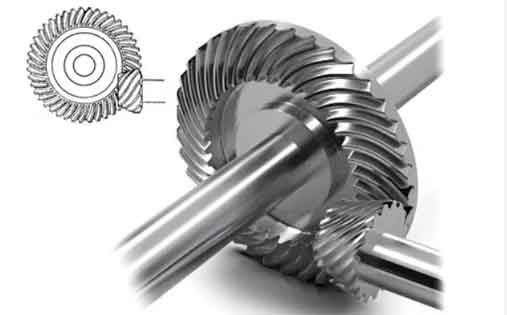The production of spiral bevel gear has seen significant advancements in machining technologies, driven by the demands for higher precision, efficiency, and cost-effectiveness in automotive and aerospace industries. These advancements have improved the quality, consistency, and performance of spiral bevel gear. Here’s a look at some key developments:

1. CNC Machining
- Precision and Flexibility: CNC (Computer Numerical Control) machining has revolutionized the production of spiral bevel gear by allowing for precise control over the cutting processes. CNC machines can produce gears with high accuracy and repeatability, which is crucial for applications requiring tight tolerances and high performance.
- Complex Geometries: The flexibility of CNC technology enables the machining of complex geometries and customized gear designs, which would be difficult or impossible with conventional machining methods.
2. Gear Grinding Machines
- Improved Surface Finish: Gear grinding machines are used to finish gears to a high surface quality. The process is particularly important for spiral bevel gear because it reduces noise levels and increases the longevity of the gear by minimizing wear.
- Enhanced Precision: Modern gear grinding machines have capabilities to achieve extremely precise tooth forms, which is critical for the smooth operation and efficiency of gear assemblies.
3. Dry Cutting Technology
- Environmentally Friendly: Dry cutting technologies eliminate the need for cooling lubricants, reducing the environmental impact of gear production. This method not only saves on the cost of fluids but also reduces waste and cleanup requirements.
- Improved Productivity: Dry cutting can increase productivity as it eliminates the time needed for cleaning and disposing of cutting fluids.
4. Five-Axis Machining
- Versatile and Efficient: Five-axis CNC machines allow for the machining of parts from virtually any direction, which is particularly advantageous for complex parts like spiral bevel gear. This capability reduces the need for multiple setups, thereby shortening production cycles and reducing errors.
- Integrated Measurement: Some five-axis machines include integrated measurement functionalities that can verify the geometry of a gear during the machining process, ensuring that the manufacturing tolerances are strictly adhered to.
5. Laser Scanning and Inspection
- High-Resolution Inspection: Laser scanning technology provides high-resolution measurements of gears, enabling precise inspection of tooth geometry, surface defects, and alignment errors. This level of inspection is essential for ensuring the quality of spiral bevel gear.
- Feedback Loop: Data collected from laser inspections can be fed back into the CNC programming to make real-time adjustments or corrections, enhancing the overall precision of the manufacturing process.
6. Adaptive Machining
- Real-Time Adjustments: Adaptive machining systems use real-time feedback from sensors to adjust cutting parameters on the fly. This adaptability is crucial for managing the variability in raw material properties and achieving uniform quality across production batches.
- Wear Compensation: These systems can also compensate for tool wear without manual intervention, maintaining optimal cutting conditions throughout the production run.
7. Additive Manufacturing
- Rapid Prototyping: Additive manufacturing, or 3D printing, offers potential for rapid prototyping of spiral bevel gear, allowing for quick design iterations and testing before full-scale production.
- Complex Lattices: It also enables the production of gears with complex lattice structures to reduce weight without compromising strength, ideal for aerospace and high-performance automotive applications.
These advancements in machining technologies not only enhance the production capabilities and efficiency of manufacturing spiral bevel gear but also contribute to improved gear performance in critical applications. As technology continues to evolve, further innovations are expected to drive even greater improvements in gear manufacturing processes.
